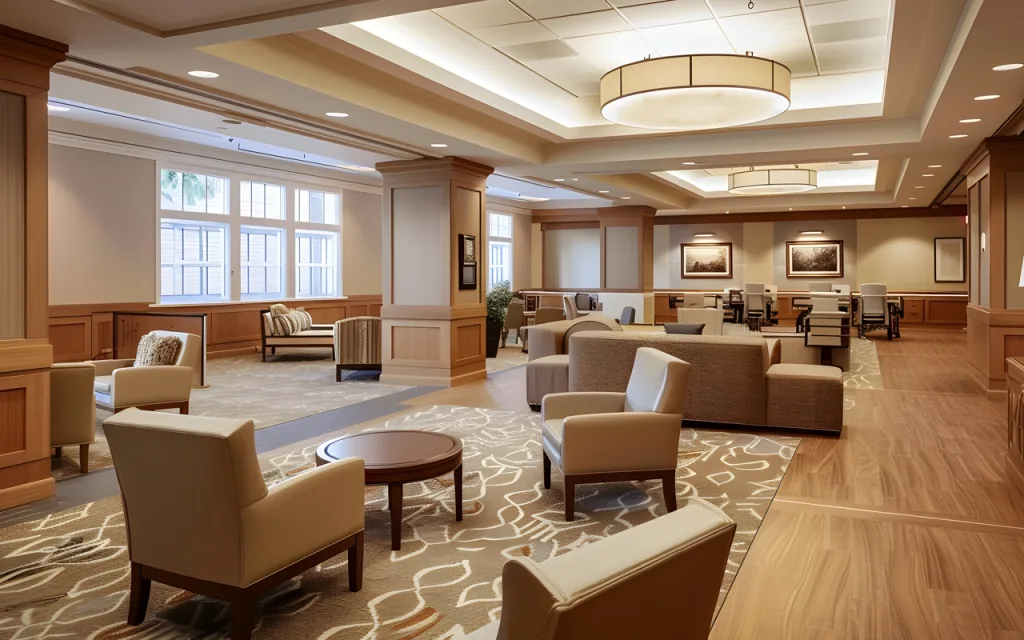
As people age, one of the most important decisions they face is selecting the right environment to live in. The space in which we reside significantly impacts our daily lives, and for seniors, this is especially true. The design and amenities of senior living communities have a direct effect on residents’ quality of life, from their physical health to their emotional and social well-being. In this blog post, we will explore how the environment in senior living communities influences senior well-being and why thoughtful design and rich amenities are key to enhancing the experience of aging.
The Importance of Environment for Senior Living
When thinking about senior care, it’s easy to assume that the primary concern is medical assistance or providing care for specific needs. However, as more seniors choose to move into senior living communities, the broader aspects of life, such as comfort, engagement, and overall environment, become just as important as physical health care. The design of senior living communities should not only address practical considerations, such as safety and accessibility, but also contribute to residents’ emotional and social well-being.
A thoughtfully designed space can create a positive atmosphere that promotes independence, reduces anxiety, and encourages social interactions. The quality of senior living environments varies significantly, and when seniors are provided with a space that fosters well-being, they can enjoy a higher quality of life. From the layout of the rooms to the amenities available, every detail contributes to the senior’s overall experience.

The Role of Design in Senior Living Communities
The physical layout and design of senior living communities are crucial to fostering an environment of comfort and safety. When designing spaces for seniors, special attention is given to accessibility, functionality, and aesthetics. Features like wide hallways, non-slip flooring, and easy-to-reach fixtures are integral for ensuring seniors can navigate their surroundings comfortably and independently.
In addition to safety features, the aesthetic design of the space has a significant impact on residents’ mood and mental health. Senior living communities with bright, open spaces, calming colors, and natural light tend to reduce feelings of isolation and depression, which are common among older adults. Design elements that reflect nature, such as gardens, walking paths, and indoor plants, provide opportunities for relaxation and connection with the outdoors.
An environment designed with seniors in mind also enhances their ability to engage with others. Common areas such as lounges, dining rooms, and recreation spaces allow for social interactions and foster a sense of community. These interactions are critical to the emotional and mental health of seniors, reducing the risk of loneliness and providing opportunities for new friendships and activities.

Amenities that Enhance Senior Care and Quality of Life
Amenities are an essential aspect of any senior living community. Well-designed amenities not only enhance comfort but also contribute to a sense of belonging and overall well-being. For example, fitness centers and walking trails can help seniors maintain an active lifestyle, improving both physical health and mental clarity. Physical exercise is known to be a key factor in reducing the risk of chronic diseases, enhancing mood, and promoting independence.
Another important amenity is access to engaging social activities. Senior living communities that offer a wide range of activities—such as arts and crafts, cooking classes, movie nights, and outings—create opportunities for seniors to stay mentally stimulated and socially active. These activities encourage seniors to form connections with others, which can help prevent feelings of isolation and foster a strong sense of community.
Dining options are another key aspect of senior care in these communities. Well-balanced, nutritious meals are essential for seniors’ health, but dining is also an opportunity for socializing. Communities that offer diverse dining options in an inviting atmosphere can help seniors feel more connected to their surroundings. Whether it’s a communal dining area or a more private setting, the ability to share meals with others has a positive impact on overall happiness.
In addition to recreational and dining amenities, access to wellness services is another critical aspect of senior living. These might include on-site medical care, physical therapy, mental health support, and other healthcare services tailored to the specific needs of older adults. With the right combination of care and amenities, senior living communities can offer a well-rounded environment that supports both physical health and emotional well-being.

How Environment Affects Emotional and Social Well-Being
The design and amenities of a senior living community play a significant role in shaping residents’ emotional and social well-being. Moving into a new living situation can be overwhelming for seniors, especially if they are leaving behind a familiar home or community. However, a welcoming, well-designed environment can make this transition easier and help seniors feel more at ease in their new surroundings.
One of the most important aspects of emotional well-being for seniors is social connection. Senior living communities that prioritize social engagement—whether through group activities, social events, or communal spaces—provide ample opportunities for residents to build relationships. These connections are critical for reducing loneliness and fostering a sense of belonging, which can greatly improve a senior’s mental health.
Additionally, the physical space itself can have a profound effect on mood. Senior living communities with bright, open spaces, beautiful views, and comfortable common areas provide seniors with a sense of calm and relaxation. In contrast, poorly designed environments that are cramped or gloomy can contribute to feelings of isolation and depression. The more inviting and comfortable the environment, the more likely it is that residents will feel positive and engaged with their surroundings.

Conclusion: Living Your Choice for Senior Well-Being
In conclusion, the environment in which seniors live has a profound impact on their overall well-being. The thoughtful design and range of amenities offered in senior living communities are crucial for ensuring residents lead fulfilling, independent, and happy lives. By focusing on accessibility, safety, aesthetics, and social opportunities, senior living communities can significantly enhance the quality of life for their residents.If you’re looking for a senior living community that prioritizes your loved one’s happiness and well-being, we encourage you to reach out to Living Your Choice. Dedicated to helping seniors find the right community based on their personal preferences and lifestyle, Living Your Choice offers guidance on choosing the best fit for both care and comfort. If you have any questions or would like assistance finding the perfect community, feel free to leave a comment below or contact us directly at Living Your Choice. We’re here to help!









